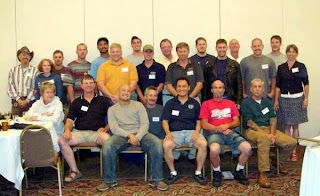
It’s not every day that field employees in the construction industry get recognized for their hard work. Unless, of course, it’s a historic election year and your name happens to be, “Joe the Plumber.”
That is why
The Durable Slate Company is proud to announce that one of its top foremen, Chad Chambers, has been presented with a national
MVP award, recognizing his expertise and dedication to the roofing industry.The award was presented last night, Feb. 4, at the
International Roofing Expo in Las Vegas. Chambers is currently in Nevada with colleagues from The Durable Slate Company.
Chambers has been a roofer for the past nine years. He has been with The Durable Slate Company for about five of those years. On working for The Durable Slate Company Chambers said, “I consider what I do to be much more than just roofing. I love the fact that the projects my crews and I complete will last a lifetime. It makes us feel great about the work we do.”
Chambers said that receiving this award proves that positive thinking and hard work really does pay off. Chambers has always been inspired by his grandparents and their strong work ethic. “I think there’s a generation gap in work ethic, faith and values. I’ve always aimed to be at the same level as my grandfather. He’s lived through wars and depression and doesn’t take things for granted," he said.
The Roofing Industry Alliance for Progress sponsors the Roofing Industry’s Most Valuable Player Awards Program, which annually identifies and honors a maximum of ten outstanding roofing workers. These individuals serve as esteemed role models, and demonstrate higher work-related and personal goals to which others may aspire.Judged on his work ethic, workmanship, creative problem solving, contribution to employee retention, leadership qualities and safety record on the projects he runs, Chambers was selected, along with nine others in the roofing industry from across the nation as an MVP by the NRCA.
Chambers is the
third Durable Slate employee to receive an MVP award.
 We try to provide useful and timely information here on The Durable Slate Company blog. However, there are times when you might need more detailed and thorough information about your historic roof. We encourage our readers to visit the National Park Service Preservation Briefs for such information.
We try to provide useful and timely information here on The Durable Slate Company blog. However, there are times when you might need more detailed and thorough information about your historic roof. We encourage our readers to visit the National Park Service Preservation Briefs for such information.





_chim+post.JPG)








 Remember my
Remember my 

 It’s not every day that field employees in the construction industry get recognized for their hard work. Unless, of course, it’s a historic election year and your name happens to be, “Joe the Plumber.”
It’s not every day that field employees in the construction industry get recognized for their hard work. Unless, of course, it’s a historic election year and your name happens to be, “Joe the Plumber.”
 Did you know that many older homes are either without felt or have deteriorated felt between their slate and wood deck? This does not provide adequate protection during harsh winters. When there is a heavy snow accumulation on the roof, the warm temperatures from inside the house can melt the snow at the bottom of the accumulation causing water to run toward the eaves. As this water runs to the eaves, it refreezes because the soffits are unheated. This can result in an ice dam at the perimeter of the house. Subsequent melting can run into this ice dam and leak into the house behind the fascia board or through the roof decking if there is not adequate dripedge or high-back gutters along with ice and water shield around the perimeter.
Did you know that many older homes are either without felt or have deteriorated felt between their slate and wood deck? This does not provide adequate protection during harsh winters. When there is a heavy snow accumulation on the roof, the warm temperatures from inside the house can melt the snow at the bottom of the accumulation causing water to run toward the eaves. As this water runs to the eaves, it refreezes because the soffits are unheated. This can result in an ice dam at the perimeter of the house. Subsequent melting can run into this ice dam and leak into the house behind the fascia board or through the roof decking if there is not adequate dripedge or high-back gutters along with ice and water shield around the perimeter.  Old House Handy Man,
Old House Handy Man,  This article
This article 



